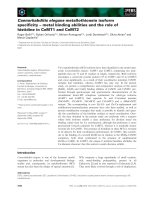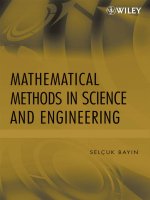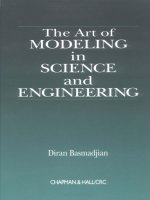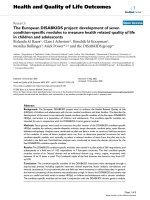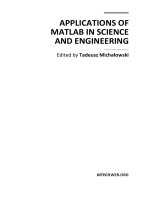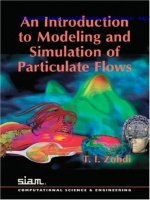APPLICATIONS OF MATLAB IN SCIENCE AND ENGINEERING potx
Bạn đang xem bản rút gọn của tài liệu. Xem và tải ngay bản đầy đủ của tài liệu tại đây (16.19 MB, 522 trang )
APPLICATIONS OF
MATLAB IN SCIENCE
AND ENGINEERING
Edited by Tadeusz Michałowski
Applications of MATLAB in Science and Engineering
Edited by Tadeusz Michałowski
Published by InTech
Janeza Trdine 9, 51000 Rijeka, Croatia
Copyright © 2011 InTech
All chapters are Open Access articles distributed under the Creative Commons
Non Commercial Share Alike Attribution 3.0 license, which permits to copy,
distribute, transmit, and adapt the work in any medium, so long as the original
work is properly cited. After this work has been published by InTech, authors
have the right to republish it, in whole or part, in any publication of which they
are the author, and to make other personal use of the work. Any republication,
referencing or personal use of the work must explicitly identify the original source.
Statements and opinions expressed in the chapters are these of the individual contributors
and not necessarily those of the editors or publisher. No responsibility is accepted
for the accuracy of information contained in the published articles. The publisher
assumes no responsibility for any damage or injury to persons or property arising out
of the use of any materials, instructions, methods or ideas contained in the book.
Publishing Process Manager Davor Vidic
Technical Editor Teodora Smiljanic
Cover Designer Jan Hyrat
Image Copyright Ali Mazraie Shadi, 2010. Used under license from Shutterstock.com
MATLAB
®
(Matlab logo and Simulink) is a registered trademark of The MathWorks, Inc.
First published August, 2011
Printed in Croatia
A free online edition of this book is available at www.intechopen.com
Additional hard copies can be obtained from
Applications of MATLAB in Science and Engineering, Edited by Tadeusz Michałowski
p. cm.
ISBN 978-953-307-708-6
free online editions of InTech
Books and Journals can be found at
www.intechopen.com
Contents
Preface IX
Chapter 1 Application of GATES and
MATLAB for Resolution of Equilibrium,
Metastable and Non-Equilibrium Electrolytic Systems 1
Tadeusz Michałowski
Chapter 2 From Discrete to Continuous Gene
Regulation Models – A Tutorial Using the Odefy Toolbox 35
Jan Krumsiek, Dominik M. Wittmann and Fabian J. Theis
Chapter 3 Systematic Interpretation of
High-Throughput Biological Data 61
Kurt Fellenberg
Chapter 4 Hysteresis Voltage
Control of DVR Based on Unipolar PWM 83
Hadi Ezoji, Abdol Reza Sheikhaleslami, Masood Shahverdi,
Arash Ghatresamani and Mohamad Hosein Alborzi
Chapter 5 Modeling & Simulation of Hysteresis
Current Controlled Inverters Using MATLAB 97
Ahmad Albanna
Chapter 6 84 Pulse Converter,
Design and Simulations with Matlab 123
Antonio Valderrábano González,
Juan Manuel Ramirez and Francisco Beltrán Carbajal
Chapter 7 Available Transfer Capability Calculation 143
Mojgan Hojabri and Hashim Hizam
Chapter 8 Multiuser Systems
Implementations in Fading Environments 165
Ioana Marcu, Simona Halunga,
Octavian Fratu and Dragos Vizireanu
VI Contents
Chapter 9 System-Level Simulations
Investigating the System-on-Chip
Implementation of 60-GHz Transceivers for
Wireless Uncompressed HD Video Communications 181
Domenico Pepe and Domenico Zito
Chapter 10 Low-Noise, Low-Sensitivity Active-RC
Allpole Filters Using MATLAB Optimization 197
Dražen Jurišić
Chapter 11 On Design of CIC Decimators 225
Gordana Jovanovic Dolecek and Javier Diaz-Carmona
Chapter 12 Fractional Delay Digital Filters 247
Javier Diaz-Carmona and Gordana Jovanovic Dolecek
Chapter 13 On Fractional-Order PID Design 273
Mohammad Reza Faieghi and Abbas Nemati
Chapter 14 Design Methodology with System
Generator in Simulink of a FHSS Transceiver on FPGA 293
Santiago T. Pérez, Carlos M. Travieso,
Jesús B. Alonso and José L. Vásquez
Chapter 15 Modeling and Control of
Mechanical Systems in Simulink of Matlab 317
Leghmizi Said and Boumediene Latifa
Chapter 16 Generalized PI Control of
Active Vehicle Suspension Systems with MATLAB 335
Esteban Chávez Conde, Francisco Beltrán Carbajal
Antonio Valderrábano González and Ramón Chávez Bracamontes
Chapter 17 Control Laws Design and Validation of Autonomous
Mobile Robot Off-Road Trajectory Tracking Based
on ADAMS and MATLAB Co-Simulation Platform 353
Yang. Yi, Fu. Mengyin, Zhu. Hao and Xiong. Guangming
Chapter 18 A Virtual Tool for Computer Aided
Analysis of Spur Gears with Asymmetric Teeth 371
Fatih Karpat, Stephen Ekwaro-Osire and Esin Karpat
Chapter 19 The Use of Matlab in Advanced
Design of Bonded and Welded Joints 387
Paolo Ferro
Chapter 20 ISPN: Modeling Stochastic with Input
Uncertainties Using an Interval-Based Approach 409
Sérgio Galdino and Paulo Maciel
Contents VII
Chapter 21 Classifiers of
Digital Modulation Based on the
Algorithm of Fast Walsh-Hadamard
Transform and Karhunen-Loeve Transform 433
Richterova Marie and Mazalek Antonin
Chapter 22 Novel Variance Based Spatial Domain
Watermarking and Its Comparison with
DIMA and DCT Based Watermarking Counterparts 451
Rajesh Kannan Megalingam, Mithun Muralidharan Nair,
Rahul Srikumar, Venkat Krishnan Balasubramanian
and Vineeth Sarma Venugopala Sarma
Chapter 23 Quantitative Analysis of Iodine Thyroid and
Gastrointestinal Tract Biokinetic Models Using MATLAB 469
Chia Chun Hsu, Chien Yi Chen and Lung Kwang Pan
Chapter 24 Modelling and
Simulation of pH Neutralization Plant
Including the Process Instrumentation 485
Claudio Garcia and Rodrigo Juliani Correa De Godoy
Preface
MATLAB (Matrix Laboratory) is a matrix-oriented tool for mathematical
programming, applied for numerical computation and simulation purposes. Together
with its dynamic simulation toolbox Simulink, as a graphical environment for the
simulation of dynamic systems, it has become a very powerful tool suitable for a large
number of applications in many areas of research and development. These areas
include mathematics, physics, chemistry and chemical engineering, mechanical
engineering, biological and medical sciences, communication and control systems,
digital signal, image and video processing, system modeling and simulation, statistics
and probability. Generally, MATLAB is perceived as a high-level language and
interactive environment that enables to perform computational tasks faster than with
traditional programming languages, such as C, C++, and Fortran.
Simulink is integrated with MATLAB as MATLAB/Simulink, i.e., data can be easily
transferred between the programs. MATLAB is supported in Unix, Macintosh, and
Windows environments. This way, Simulink is an interactive environment for
modeling, analyzing, and simulating a wide variety of dynamic systems.
The use of MATLAB is actually increasing in a large number of fields, by combining
with other toolboxes, e.g., optimization toolbox, identification toolbox, and others. The
MathWorks Inc. periodically updates MATLAB and Simulink, providing more and
more advanced software. MATLAB handles numerical calculations and high-quality
graphics, provides a convenient interface to built-in state-of-the-art subroutine
libraries, and incorporates a high-level programming language. Nowadays, the
MATLAB/Simulink package is the world’s leading mathematical computing software
for engineers and scientists in industry and education.
Due to the large number of models and/or toolboxes, there is still some work or
coordination to be done to ensure compatibility between the available tools. Inputs
and outputs of different models are to-date defined by each modeler, a connection
between models from two different toolboxes can thus take some time. This should be
normalized in the future in order to allow a fast integration of new models from other
toolboxes. The widespread use of these tools, is reflected by ever-increasing number of
books based on the MathWorks Inc. products, with theory, real-world examples, and
exercises.
X Preface
This book presents a review of some activities in modeling and simulation processes.
Chapter 1 is devoted to the Generalized Approach To Electrolytic Systems (GATES),
applicable for resolution of electrolytic systems of any degree of complexity with use
of iterative computer programs (e.g., one offered by MATLAB) applied to the set of
non-linear equations, where all physicochemical knowledge can be involved. The
Generalized Electron Balance (GEB), immanent in formulation of all redox systems, is
considered in categories of general laws of the matter preservation.
MATLAB programs are also related to biological sciences. Chapter 2 presents the
Odefy toolbox and indicates how to use it for modeling and analyzing molecular
biological systems. The concepts of steady states, update policies, state spaces, phase
planes and systems parameters are also explained. Applicability of Odefy toolbox for
studies on real biological systems involved with stem cell differentiation, immune
system response and embryonal tissue formation is also indicated.
Much of the data obtained in molecular biology is of quantitative nature. Such data are
obtained with use of 2D microarrays, e.g., DNA or protein microarrays, containing 104
- 105 spots arranged in the matrix form (arrayed) on a chip, where e.g., many parallel
genetic tests are accomplished (note that all variables in MATLAB are arrays). For
effective handling of the large datasets, different bioinformatic techniques based on
matrix algebra are applied to extract the information needed with the use of MATLAB.
A review of such techniques in provided in Chapter 3.
A reference of MATLAB to physical sciences is represented in this book by a series of
chapters dealing with electrical networks, communication/information transfer and
filtering of signals/data. There are Chapters: 4 (on a hysteresis voltage control
technique), 5 (on hysteresis current controlled inverters), 6 (on voltage source
converter), 7 (on power transmission networks), 8 (on fading in the communication
channel during propagation of signals on multiple paths between transmitter and
receiver), 9 (on wireless video communication), 10 (on active RC-filters done to
diminish random fluctuations in electric circuits caused by thermal noise), 11 (on comb
filter, used for decimation, i.e., reduction of a signal sampling rate), 12 (on fractional
delay filters, useful in numerous signal processing), and 13 (on tuning methods).
MATLAB is an interactive environment designed to perform scientific and engineering
calculations and to create computer simulations. Simulink as a tool integrated with
MATLAB, allows the design of systems using block diagrams in a fast and flexible
way (Chapter 14). In this book, it is applied for: mechanical systems (Chapter 15);
hydraulic and electromagnetic actuators (Chapter 16); control of the motion of
wheeled mobile robot on the rough terrain (Chapter 17); comparative study on spur
gears with symmetric and asymmetric teeth (Chapter 18); thermal and mechanical
models for welding purposes (Chapter 19). A toolbox with stochastic Markov model is
presented in Chapter 20.
Preface XI
Some operations known from statistical data analysis are also realizable with use of
MATLAB, namely: cluster analysis (modulation recognition of digital signals, Chapter
21) and pattern recognition (digital image watermarking, Chapter 22).
The last two chapters discuss the registration of radioactive iodine along the
gastrointestinal tract (Chapter 23), and acid-base neutralization in continuously stirred
tank reactor (Chapter 24).
Tadeusz Michałowski
Cracow University of Technology, Cracow
Poland
1
Application of GATES and MATLAB
for Resolution of Equilibrium, Metastable
and Non-Equilibrium Electrolytic Systems
Tadeusz Michałowski
Faculty of Chemical Engineering and Technology,
Cracow University of Technology, Cracow,
Poland
1. Introduction
The Generalized Approach To Electrolytic Systems (GATES) (Michałowski, 2001, 2010)
provides the possibility of thermodynamic description of equilibrium and metastable, redox
and non-redox, mono-, two- and three-phase systems, with the possibility of all
attainable/pre-selected physicochemical knowledge to be involved, with none simplifying
assumptions done for calculation purposes, where different types of reactions occur in batch
or dynamic systems, of any degree of complexity. The Generalized Electron Balance (GEB)
concept, devised and formulated by Michałowski (1992), and obligatory for description of
redox systems, is fully compatible with charge and concentration balances, and relations for
the corresponding equilibrium constants. Up to 1992, the generalized electron balance (GEB)
concept was the lacking segment needed to formulate the compatible set of algebraic
balances referred to redox systems. The GEB is also applicable for the systems where radical
species are formed. Shortly after GEB formulation, the GATES involving redox systems of
any degree of complexity, was elaborated.
In this chapter, some examples of complex redox systems, where all types of elementary
chemical reactions proceed simultaneously and/or sequentially, are presented. In all
instances, one can follow measurable quantities (potential E, pH) in dynamic and static
processes and gain the information about details not measurable in real experiments; it
particularly refers to dynamic speciation. In the calculations made according to iterative
computer programs, e.g., MATLAB, all physicochemical knowledge can be involved and
different “variations on the subject” are also possible; it particularly refers to metastable and
non-equilibrium systems. The Generalized Equivalent Mass (GEM) concept, also devised
(1979) by Michałowski (Michałowski et al., 2010), has been suggested, with none relevance
to a chemical reaction notation. Within GATES, the chemical reaction notation is only the
basis to formulate the expression for the related equilibrium constant.
2. GEB
In order to formulate GEB for a particular redox system, two equivalent approaches were
suggested by Michałowski. The first approach (Michałowski, 1994; Michałowski and Lesiak,
Applications of MATLAB in Science and Engineering
2
1994a,b) is based on the principle of a “common pool” of electrons, introduced by different
species containing the electron-active elements participating redox equilibria. The
disproportionation reaction is a kind of dissipation of electrons between the species formed
by dissipating element, whereas the transfer of electrons between two (or more) interacting
elements in a redox system resembles a “card game”, with active elements as gamblers,
electrons - as money, and non-active elements - as fans.
The second approach (Michałowski, 2010) results from juxtaposition of elemental balances
for hydrogen (H) and oxygen (O). For redox systems, the balance thus obtained is
independent on charge and concentration balances, whereas the related balance, when
referred to non-redox systems, is the linear combination of charge and concentration
balances, i.e. it is not a new, independent balance (Fig. 1). Any non-redox system is thus
described only by the set of charge and s concentration balances, together s+1 linearly
independent balances. Any redox system is described with use of charge, electron (GEB)
and s concentration balances, together s+2 linearly independent balances. Charge balance
results from balance of protons in nuclei and orbital electrons of all elements in all species
forming the electrolytic system considered.
For redox systems, the balance obtained according to the second approach can be
transformed (Michałowski, 2010) into the form ascribed to the first approach. In the second
approach, we are not forced to calculate oxidation degrees of elements in particular species;
it is an advantageous occurrence, of capital importance for the systems containing complex
organic compounds, their ions and/or radicals.
The principles of minimizing (zeroing) procedure, realized within GATES according to
iterative computer program, are exemplified e.g., in (Michałowski, 1994; Michałowski and
Lesiak, 1994a).
Fig. 1. The place of electron balance (GEB) within elemental balances.
3. General characteristics of electrolytic systems
Electrolytic systems can be considered from thermodynamic or kinetic viewpoints. The
thermodynamic approach can be applied to equilibrium or metastable systems. In
equilibrium systems, all reaction paths are accessible, whereas in metastable systems at
least one of the reaction paths, attainable (virtually) from equilibrium viewpoint, is
Application of GATES and MATLAB for Resolution of
Equilibrium, Metastable and Non-Equilibrium Electrolytic Systems
3
inaccessible, i.e. the activation barriers for some reaction paths are not crossed, and the
resulting reactions cannot proceed, under defined conditions. It particularly refers to
aqueous electrolytic systems, where less soluble gaseous species, such as H
2
or O
2
, can
virtually be formed, provided that this process is not hampered by obstacles of different
nature. However, formation of the presupposed gas bubbles in the related solution, needs
a relatively great expenditure of volumetric work, ΔL
p
dV
, made against the
surrounding solution, by gas molecules forming the bubble. The ΔL value can be
recalculated on an overvoltage ΔU = ΔL/q, where q is the charge consumed/released in
the (virtual) reduction/oxidation process. Owing to the fact that the particular bubble
assumes a macroscopic dimension, ΔL and then ΔU values are high. Particularly,
ΔU referred to the (presupposed) formation of O
2
, cannot be covered by the oxidation
potential of MnO
4
-1
in aqueous medium and the (virtual) reaction 4MnO
4
-1
+ 4H
+1
=
4MnO
2
+ 3O
2
+ 2H
2
O does not occur, even at elevated temperatures. Another kind of
obstacles resulted from formation of a hydroxide/oxide layer on surface of a metal
(e.g., Mg, Al) introduced into pure water; these layers protect further dissolution of the
metal and formation of H
2
.
One can distinguish static (batch) and dynamic electrolytic systems, resolvable within
GATES. The dynamic process, most commonly applied in laboratory practice, is the
titration, where titrant (T) is added into titrand (D), and the D+T system is thus formed. In
D+T systems considered in chemical analysis, different (acid–base, redox, complexation
or/and precipitation, extended on two- and three-phase (liquid-liquid extraction systems)
types of reactions may occur simultaneously and/or sequentially and, moreover, a
particular type of a reaction, e.g., complexation, can be exemplified by different
representatives, e.g., different ligands.
Modelling the electrolytic systems consists of several interacting steps, indicated in Fig. 2.
The collected preliminary data are of qualitative and quantitative nature. The qualitative
aspect refers to specification of particular components (species), whereas quantitative aspect
relates to equilibrium constants, involving particular species of the system. Later on, only
the steps involved with calculations, data handling and knowledge gaining will be
discussed.
4. Rules of conservation
In chemical systems, one can refer to different rules of conservation, due to elements,
protons, electrons and external charges of species – particularly the species entering the
electrolytic systems, where none nuclear transformations of elements occur. Some rules of
conservation are interrelated, and this fact is referred to systems of any degree of
complexity. This way, the problem of interdependency of the balances arises. Starting from
the rules of conservation viewpoint, it is assumed, that any electrolytic system, composed of
condensed (liquid, liquid+solid, liquid1+liquid2, or liquid1+liquid2+solid) phases
(Michałowski and Lesiak, 1994a) is separated from its surroundings by diathermal walls,
that enable any process in the closed system to proceed under isothermal conditions. In such
systems, the mass transport can occur only between the phases consisting such a system. In
thermodynamic considerations of dynamic electrolytic systems it is also assumed that all the
processes occur in quasistatic manner.
Applications of MATLAB in Science and Engineering
4
Fig. 2. Steps of modelling any electrolytic system: 1 – Collection of preliminary data;
2 – Preparation of computer program; 3 – Calculations and data handling; 4 – Gaining of
knowledge.
As were stated above, the linear combination of elemental balances for hydrogen (H) and
oxygen (O), referred to redox systems in aqueous media, provides the balance equivalent to
GEB, in its primary form. In formulation of the balances, formation of hydrated forms
i
z
i2
i
X×nHO (n
i
≥ 0) of ionic (z
i
≠0) and/or nonionic (z
i
=0) species
i
z
i
X is admitted in
considerations. The GEB, referred to a redox system, is fully compatible with other (charge
and concentration) balances related to this system and is linearly independent from that
balances.
5. Formulation of GEB
5.1 Batch redox systems
5.1.1 Fenton reagent
The Fenton reagent is usually obtained by mixing FeSO
4
and H
2
O
2
solutions. In order to
describe this redox system quantitatively, let us consider the monophase system (solution)
of volume V
0
[L], composed of N
01
molecules of FeSO
4
·7H
2
O, N
02
molecules of H
2
O
2
and
N
0W
molecules of H
2
O introduced with H
2
O
2
solution (e.g., perhydrol), and N
W
molecules of
H
2
O as the solvent. The solution: H
2
O (N
1
), H
+1
(N
2
, n
2
), OH
-1
(N
3
, n
3
), OH (N
4
, n
4
), H
2
O
2
(N
5
,
n
5
), HO
2
-1
(N
6
, n
6
), HO
2
(N
7
, n
7
), O
2
-1
(N
8
, n
8
), O
2
(N
9
, n
9
), Fe
+2
(N
10
, n
10
), FeOH
+1
(N
11
, n
11
),
FeSO
4
(N
12
, n
12
), Fe
+3
(N
13
, n
13
), FeOH
+2
(N
14
, n
14
), Fe(OH)
2
+1
(N
15
, n
15
), Fe
2
(OH)
2
+4
(N
16
, n
16
),
FeSO
4
+1
(N
17
, n
17
), Fe(SO
4
)
2
-1
(N
18
, n
18
), HSO
4
-1
(N
19
, n
19
), SO
4
-2
(N
20
, n
20
), where N
i
is the
number of entities X
i
with mean number n
i
of hydrating water particles attached to it, n
i
≥ 0.
Balances for H and O are as follows:
2·N
1
+N
2
·(1+2n
2
)+N
3
·(1+2n
3
)+N
4
·(1+2n
4
)+N
5
·(2+2n
5
)+N
6
·(1+2n
6
)+
N
7
·(1+2n
7
)+N
8
·2n
8
+N
9
·2n
9
+N
10
·2n
10
+N
11
·(1+2n
11
)+N
12
·2n
12
+
N
13
·2n
13
+N
14
·(1+2n
14
)+N
15
·(2+2n
15
)+N
16
·(2+2n
16
)+N
17
·2n
17
+N
18
·2n
18
+
N
19
·(1+2n
19
)+N
20
·2n
20
=14·N
01
+2·N
02
+2·N
0W
+2·N
W
(1)
Application of GATES and MATLAB for Resolution of
Equilibrium, Metastable and Non-Equilibrium Electrolytic Systems
5
N
1
+N
2
·n
2
+N
3
·(1+n
3
)+N
4
·(1+n
4
)+N
5
·(2+n
5
)+N
6
(2+n
6
)+N
7
(2+n
7
)+
N
8
·(2+n
8
)+N
9
·(2+n
9
)+N
10
·n
10
+N
11
(1+n
11
)+N
12
·(4+n
12
)+N
13
·n
13
+
N
14
·(1+n
14
)+N
15
·(2+n
15
)+N
16
·(2+n
16
)+N
17
·(4+n
17
)+N
18
·(8+n
18
)+
N
19
(4+n
19
)+N
20
·(4+n
20
)=11·N
01
+2·N
02
+N
0W
+N
W
(2)
From (1) and (2) we have
-N
2
+N
3
+N
4
+2N
5
+3N
6
+3N
7
+4N
8
+4N
9
+ N
11
+8N
12
+N
14
+
2N
15
+2N
16
+8N
17
+16N
18
+7N
19
+8N
20
=8N
01
+2N
02
(3)
Adding the sides of (3) and:
+N
2
–N
3
–N
6
–N
8
+2N
10
+N
11
+3N
13
+2N
14
+N
15
+4N
16
+N
17
–N
18
–N
19
–2N
20
=0
6N
01
=6N
12
+6N
17
+12N
18
+6N
19
+6N
20
after cancellation of similar terms, one obtains the relation
N
4
+2N
5
+2N
6
+3N
7
+3N
8
+4N
9
+2N
10
+2N
11
+2N
12
+
3N
13
+3N
14
+3N
15
+6N
16
+3N
17
+3N
18
=2N
01
+2N
02
(4)
Dividing the sides of (6) by N
A
·V
0
, we get the simple form of GEB related to this system
[OH]+2·([H
2
O
2
]+[HO
2
-1
])+3·([HO
2
]+[O
2
-1
])+4·[O
2
]+
2·([Fe
+2
]+[FeOH
+1
]+[FeSO
4
])+3·([Fe
+3
]+[FeOH
+2
]+[Fe(OH)
2
+1
]+ (5)
2·[Fe
2
(OH)
2
+4
]+[FeSO
4
+1
]+[Fe(SO
4
)
2
-1
])=2·C
01
+2·C
02
where [X
i
] = N
i
/( N
A
·V
0
), C
0j
= N
0j
/( N
A
·V
0
). Hydrating water particles at the corresponding
species X
i
are omitted in (5), for simplicity of notation. Eq. (5) involves only the elements
participating redox equilibria; the electrons of sulfur in sulfate species do not participate the
redox equilibria. Note that the radical species (OH, HO
2
) are involved in (5), and O
2
is the
biradical.
For redox systems, the balance obtained according to the second approach can be
transformed into the form ascribed to the first approach. However, in the second approach
we are not forced to define/calculate oxidation degrees of elements; it is a very
advantageous occurrence, of capital importance for the systems with complex organic
compounds, their ions and/or radicals.
5.1.2 A generalizing notation
Let us consider the electrolytic system, where the species of H
p
O
q
X
r
+z
·n
pqrz
H
2
O type (z =
z
pqrz
= 0, ±1, ±2,…; n
pqrz
≥ 0) are formed after introducing the substance H
P
O
Q
X
R
·nH
2
O into
water. From comparison of the elemental balances, we get the equation (Michałowski, 2010)
+z
Xpqrpqrz2X
pqrz
(r Z +p-2q-z) [H O X n H O]=(R Z +P-2Q) C
(6)
where Z
X
is the atomic number for the element X; the set of indices (p,q,r,z) covered by the
sum in (6) is different from: (2,1,0,0) for H
2
O, (1,0,0,1) for H
+1
, and (1,1,0,–1) for OH
–1
. It is
assumed that H
P
O
Q
X
R
·nH
2
O does not react (as oxidizing or reducing agent) with water, i.e.
products of water oxidation or reduction are not formed. For example, after introducing Br
2
(X = Br; P=Q=n=0, R=2; Z
X
= Z
Br
= 35) into water, the following bromine species are formed
Applications of MATLAB in Science and Engineering
6
as hydrates in the disproportionation process: HBrO
3
(p=r=1, q=3, z=0), BrO
3
-1
(p=0, r=1,
q=3, z=–1), HBrO (p=q=r=1, z=0), BrO
-1
(p=0, q=r=1, z=–1), Br
2
(p=q=z=0, r=2), Br
3
-1
(p=q=0,
r=3, z=–1), Br
-1
(p=q=0, r=1, z= –1). Applying Eq. 6, we get (Michałowski, 1994)
(Z
Br
–5)([HBrO
3
]+[BrO
3
-1
])+(Z
Br
–1)([HBrO]+[BrO
-1
])+2Z
Br
[Br
2
]+
(3Z
Br
+1)[Br
3
-1
]+(Z
Br
+1)[Br
-1
]=2Z
Br
·C
(7)
where C [mol/L] is the total concentration of Br
2
. In (7), hydrating water particles are
omitted, for simplicity.
For comparative purposes, one can refer to (a) Br
2
(C) + KBr (C
1
); (b) NaBrO (C
2
); (c) KBrO
3
(C
3
) + KBr (C
1
) solutions. In all instances, the left side of (7) is identical, whereas the right side
is as follows: 2Z
Br
C + (Z
Br
+1)C
1
for (a); (Z
Br
-1)C
2
for (b); (Z
Br
-5)C
3
+ (Z
Br
+1)C
1
for the case (c).
5.2 Dynamic redox systems
In physicochemical/analytical practice, a dynamic system is usually realized according to
titrimetric mode, where V mL of titrant (T) is added into V
0
mL of titrand (D). Assuming
additivity in volumes, V
0
+V of D+T system is thus formed. In common redox titrations, two
or more elements, represented by different species, can participate redox equilibria.
5.2.1 FeSO
4
+H
2
SO
4
+KMnO
4
This system be referred to titration of V
0
mL D, composed of FeSO
4
(C
0
) + H
2
SO
4
(C
1
), with V
mL of C mol/L KMnO
4
as T. The electron balance (GEB) has the form (Z
1
= 25 for Mn, Z
2
= 26
for Fe):
(Z
1
-7)[MnO
4
-1
] + (Z
1
-6)[MnO
4
-2
] + (Z
1
-3)([Mn
+3
] + [MnOH
+2
] +
γ
1
[MnSO
4
+1
] + γ
2
[Mn(SO
4
)
2
-1
]) + (Z
1
-2)([Mn
+2
] + [MnOH
+1
] + [MnSO
4
]) +
(Z
2
-2)([Fe
+2
] + [FeOH
+1
] + [FeSO
4
] + (Z
2
-3)([Fe
+3
] + [FeOH
+2
] + [Fe(OH)
2
+1
] +
2[Fe
2
(OH)
2
+4
] + [FeSO
4
+1
] + [Fe(SO
4
)
2
-1
]) - ((Z
2
-2)C
0
V
0
+ (Z
1
-7)CV)/(V
0
+V) = 0
(8)
The symbols: γ
1
and γ
2
in (8) are referred to the pre-assumed sulphate complexes (see Fig.
18A); γ
1
= 1, γ
2
= 0 if only MnSO
4
+1
is pre-assumed, and γ
1
= γ
2
= 1 if both (MnSO
4
+1
and
Mn(SO
4
)
2
-1
) complexes be pre-assumed.
5.2.2 KIO
3
+HCl+H
2
SeO
3
(+HgCl
2
)+ ascorbic acid
An interesting/spectacular example is the titration of V
0
mL of D containing KIO
3
(C
0
mol/L) + HCl (C
a
mol/L) + H
2
SeO
3
(C
Se
mol/L) + HgCl
2
(C
Hg
mol/L) with V mL of C
mol/L ascorbic acid (C
6
H
8
O
6
) as T. For example, the electron balance (GEB) referred to this
system can be written as follows (Michałowski, 2010):
(Z
1
+1)[I
–1
]+(3Z
1
+1)[I
3
–
]+2Z
1
([I
2
]+[I
2
])+(Z
1
–1)([HIO]+[IO
–1
])+(Z
1
–5)([HIO
3
]+[IO
3
–1
])+
(Z
1
–7)([H
5
IO
6
]+[H
4
IO
6
–1
]+[H
3
IO
6
–2
])+(Z
2
–2)([Hg
+2
]+[HgOH
+1
]+[Hg(OH)
2
])+
(Z
2
–2+Z
1
+1)[HgI
+1
]+(Z
2
–2+2(Z
1
+1))[HgI
2
]+(Z
2
–2+3(Z
1
+1))[HgI
3
–1
]+
(Z
2
–2+4(Z
1
+1))[HgI
4
–2
]+2(Z
2
–1)([Hg
2
+2
]+[Hg
2
OH
+1
])+Z
3
([C
6
H
8
O
6
]+[C
6
H
7
O
6
–1
]+
[C
6
H
6
O
6
–2
])+(Z
3
–2)[C
6
H
6
O
6
]+(Z
4
+1)[Cl
–1
]+2Z
4
[Cl
2
]+(Z
4
–1)([HClO]+[ClO
–1
])+
(Z
4
–3)([HClO
2
]+[ClO
2
–1
])+(Z
4
–4)[ClO
2
]+(Z
4
–5)[ClO
3
–1
]+(Z
4
–7)[ClO
4
–1
]+ (9)
(Z
1
+Z
4
)[ICl]+(Z
1
+2(Z
4
+1))[ICl
2
–1
]+(2Z
1
+Z
4
+1)[I
2
Cl
–1
]+(Z
2
–2+Z
4
+1)[HgCl
+1
]+
(Z
2
–2+2(Z
4
+1))[HgCl
2
]+(Z
2
–2+3(Z
4
+1))[HgCl
3
–1
]+(Z
2
–2+4(Z
4
+1))[HgCl
4
–2
]+
(Z
5
–4){[H
2
SeO
3
]+[HSeO
3
–1
]+[SeO
3
–2
])+(Z
5
–6)([HSeO
4
–1
]+[SeO
4
–2
])–
((Z
1
–5)C
0
V
0
+(Z
2
–2+2(Z
4
+1))C
Hg
V
0
+Z
3
CV+(Z
4
+1)C
a
V
0
+(Z
5
–4)C
Se
V
0
)/(V
0
+V)=0
Application of GATES and MATLAB for Resolution of
Equilibrium, Metastable and Non-Equilibrium Electrolytic Systems
7
where Z
1
, Z
2
, Z
4
, Z
5
are atomic numbers for I, Hg, Cl and Se, respectively; Z
3
is the number
ascribed to ascorbic acid. The following terms were introduced in there:
= 1, valid under assumption that solid iodine (I
2
) is present in the system considered;
= 0, for a system not saturated against solid iodine (I
2
refers to soluble form of iodine);
= 1 refers to the case, where Se(VI) species were involved; at = 0, the Se(VI) species
are omitted;
= 1 refers to the case, where Hg(I) species were involved; at = 0, the Hg(I) species are
omitted.
6. Charge and concentration balances
The set of balances referred to non-redox systems consists of charge and concentration
balances. For redox systems, this set is supplemented by electron balance (GEB).
For example, the charge and concentration balances referred to C mol/L Br
2
(see section
5.1.2)
[H
+1
]–[OH
-1
]–[BrO
3
-1
]–[BrO
-1
]–[Br
3
-1
]–[Br
-1
]=0 (10)
[HBrO
3
] + [BrO
3
-1
] + [HBrO] + [BrO
-1
] + 2[Br
2
] + 3[Br
3
-1
] + [Br
-1
] = 2C (11)
are supplemented by Eq. (7), i.e. (7), (10) and (11) form the complete set of balances related
to aqueous solution of Br
2
(C mol/L).
Charge and concentration balances referred to the systems 5.2.1 and 5.2.2 are specified in
(Michałowski and Lesiak, 1994b, Michałowski et al., 1996) and (Michałowski and Lesiak,
1994b, Michałowski, 2010), respectively. For example, the species involved in the system
5.2.2 enter s+2 = 7 balances: GEB, charge balance, and five concentration balances; K
+1
ions,
as a sole potassium species in this system, enters simply the related charge balance, i.e.
concentration balance for K
+1
is not formulated. Generally, concentration balances are not
formulated for the species not participating other (acid-base, complexation, precipitation or
redox) equilibria in the system considered.
7. Equilibrium constants
Different species in the system are interrelated in expressions for the corresponding
equilibrium constants, e.g., ionic product of water, dissociation constants (for acidic species),
stability constants of complexes, solubility products, standard potentials (E
0i
) for redox
reactions, partition constants in liquid-liquid extraction systems. Except E
0i
, all equilibrium
constants are formulated immediately on the basis of mass action law.
The redox systems are completed by relations for standard potentials (E
0i
), formulated on
the basis of the Nernst equation for potential E, referred to i-th redox reaction notation,
written in the form
1
i
z e
, where z
i
> 0 is the number of electrons (e
-1
) participating
this reaction. First, the equilibrium constant (K
ei
) for the redox reaction is formulated on the
basis of mass action law and then the relations:
i0i
zE/S
ei
K10
and
1E/S
[e ] 10
(12)
are applied, where S = R
T/F·ln10, and T , R, F are as ones in the Nernst equation. Both types
of constraints, i.e. balances and the expressions for equilibrium constants, are of algebraic
Applications of MATLAB in Science and Engineering
8
nature. It enables to consider the relations as common algebraic equations, nonlinear in their
nature.
In order to avoid inconsistency between the equilibrium constants values found in
literature, the set of independent equilibrium constants is required. One should also be
noted that some species are presented differently, see e.g., pairs: AlO
2
-1
and Al(OH)
4
-1
;
H
2
BO
3
-1
and B(OH)
4
-1
; IO
4
-1
and H
4
IO
6
-1
, differing in the number of water molecules
involved. The species compared here should be perceived as identical ones and then cannot
enter the related balances, side by side, as independent species.
The balances and complete set of interrelations resulting from expressions for independent
equilibrium constants are the basis for calculations made according to an iterative computer
program, e.g., MATLAB. The results thus obtained can be presented graphically, at any pre-
assumed system of coordinates, in 2D or 3D space.
The procedure involved with the terms β and γ expresses the principle of “variation on the
subject” applied to the system in question. The system considered in 5.2.2 is described with
use of the set of 36 independent equilibrium constants in the basic version, i.e. at β=γ=0.
More equilibrium data are involved, if some “variations on the subject” be done, i.e. when
some reaction paths are liberated. In the “variations” of this kind, further physicochemical
data are applied (see section 11.2).
8. Calculation procedure
The balances, related to a dynamic system and realised according to titrimetric mode, can be
written as a set of algebraic equations
k
F ( (V))=0x
(13)
where
x(V) = [x
1
(V), , x
n
(V)]
T
is the vector of basic (independent, fundamental) variables
x
i
= x
i
(V) (scalars) related to a particular V–value, i.e. volume of titrant added. The number
(n) of variables is equal to the number of the balances. At defined V–value, only one vector,
x = x(V), exists that turns the set of algebraic expressions F
k
(x(V)) to zero, i.e. F
k
(x(V)) = 0
(k=1, ,n) and zeroes the sum of squares
n
2
k
k=1
SS(V)= (F ( (V))) =0
x
(14)
for any V–value. If
x
s
(V) is the vector referred to starting (s) values for basic variables related
to a particular V–value, then one can expect that
x
s
(V) ≠ x(V) and
n
2
ks
k=1
SS(V)= (F ( (V))) >0
x
(15)
The searching of
x(V) vector values related to different V, where F
k
(x(V)) = 0 (k=1, ,n), is
made according to iterative computer programs, e.g., MATLAB. The searching procedure
satisfies the requirements put on optimal
x(V) values, provided that SS value (Eq. 15) is
lower than a pre–assumed, sufficiently low positive –value, >0, e.g., = 10
–14
. i.e.
n
2
k
k=1
SS(V)= (F ( (V))) <δ
x
Application of GATES and MATLAB for Resolution of
Equilibrium, Metastable and Non-Equilibrium Electrolytic Systems
9
However, the iterative computer programs are (generally) designed for the curve–fitting
procedures where the degree of fitting a curve to experimental points is finite. In this case,
the criterion of optimisation is based on differences SS(V,N+1) – SS(V,N) between two
successive (Nth and N+1th) approximations of SS(V)–value, i.e.
SS(V,N+1)-SS(V,N) <δ (16)
at a sufficiently low
–value. However, one should take into account that the inequality
(16) can be fulfilled at local minimum different from the global minimum. It can happen if
the starting values
x
s
(V) are too distant from the true value x(V) where the equality
(14) is fulfilled. In this case, one should try (repeat) the calculations for new
x
s
(V) values
guessed.
The choice of
–value depends on the scale of analytical concentrations considered. To
‘equalise’ the requirements put on particular balances, it is advised to apply ‘normalised’
balances, obtained by dividing the related balance by total (analytical) concentration
involved in this balance.
In all simulated titrations considered below, the following regularities are complied:
1.
The independent variables x
i
= x
i
(V) are introduced as the (negative) powers of 10 (as
the base number);
For any [X] > 0 one can write [X]
10
log[X]
= 10
–pX
, where pX = – log[X]. One should be noted
that [X] > 0 for any real pX value, pX
. It particularly refers to protons (X = H
+
) and
electrons (Eq. 12). Such choice of the basic variables improves the course of iteration
procedure.
2.
The changes in the system are made according to titrimetric mode, with volume V taken
as the steering variable.
3.
It is advisable to refer the fundamental variables to the species whose concentrations
predominate at the start for calculations.
The minimizing procedure starts at the V–value, V = V
s
, that appears to be ‘comfortable’
from the user’s viewpoint, where the starting
x
s
(V) values are guessed. Then the
optimisation is realised, with negative step put on the V–variable, up to V = V(begin) close
to zero value. The possible changes in the phase composition during the iteration procedure
should also be taken into account. It particularly refers to formation/disappearance of a
solid phase(s) or a change in equilibrium solid phase; the latter problem is raised in section
12. For this purpose, the expressions identical with the forms of the corresponding solubility
products should be ‘peered’ during the simulated procedure. In the system considered in
section 5.2.2, the solid iodine,
I
2
, is formed within defined V-range.
The results thus obtained enable to calculate all variables of interest. It refers both to
fundamental variables such as E, pH and concentrations, and other concentrations of interest.
For example, the Br
2
+ H
2
O (batch) system is described by three balances: (7), (10), (11).
In this case, one can choose three fundamental variables: pH, E and pBr, involved with
concentrations and referred to negative powers of the base 10: [H
+1
] = 10
-pH
, [e
-1
] = 10
-E/S
(Eq. 12), [Br
-1
] = 10
-pBr
. Three independent variables involved in three balances give here a
unique solution for (x
1
, x
2
, x
3
) = (pH, E, pBr), at a pre-assumed C value (Eq. 11). On this basis,
one can calculate concentrations of all other species, e.g.:
[BrO
3
-1
]=10
6A(E–1.45)+6pH–pBr
;[Br
2
]=10
2A(E–1.087)–2pBr
(17)
where the fundamental variables are involved; A = 1/S (Eq. 12).
Applications of MATLAB in Science and Engineering
10
In a simulated titration, as a representation of dynamic system, the set of parameters
involve: volume V
0
of D and concentrations of reagents in D and T. Volume V of T is a
steering variable/parameter value, at a given point of the titration.
The results of calculations provide the basis for graphical presentation of the data, in 2D or
3D space, that appears to be very useful, particularly in the case of the titrations. The curves
for concentrations of different species X
j
as a function of volume V are named as speciation
curves, plotted usually in semi-logarithmic scale, as the log[X
j
] vs. V relationships.
For comparative purposes, it is better to graph the plots as the function of the fraction
titrated
00
CV
Φ=
CV
(18)
where C
0
is the concentration [mol/L] of analyte A in D of initial volume V
0
, V is the volume
[mL] of T added up to a given point of titration, C [mol/L] – concentration of a reagent B
(towards A) in T; e.g., for the D+T system presented in section 5.2.2 we have: A = IO
3
-1
, B =
C
6
H
8
O
6
. The course of the plots E = E(V) and/or pH = pH(V) (or, alternately, pH = pH(Φ)
and/or E = E(Φ)) is the basis to indicate the equivalence point(s) according to GEM
(Michałowski et al., 2010), with none relevance to the chemical reaction notation.
The plots pH = pH(V) and/or E = E(V) can also be obtained experimentally, in
potentiometric (pH or E) titrations. Comparing the experimental plots with the related
curves obtained in simulated titrations, (a) one can check the validity of physicochemical
data applied in calculations, and (b) to do some “variations on the subject” involved with
reaction pathways and/or incomplete/doubtful physicochemical data.
9. Graphical presentation of the data referred to redox systems
9.1 Aqueous solutions of Br
2
(batch system)
The properties of aqueous bromine (Br
2
, C mol/L) solutions, considered as a weak acid, are
presented in Figures 3a-d, for different C values (Eq. (11)). As wee see, E decreases (Fig. 3a)
and pH increases with decrease in C value. The pH vs. E relationship is nearly linear in the
indicated C-range (Fig. 3c). The Br
2
exists as the predominating bromine species at higher C
values (Fig. 3d); it corresponds with the speciation plots presented in Fig. 4.
9.2 Examples of redox titration curves
9.2.1 Titration in Br
2
+NaOHandHBrO+NaOHsystems
As a result of NaOH addition into the solution of (a) Br
2
, (b) HBrO, acid-base and redox
reactions proceed simultaneously; a decrease in E is accompanied by pH growth, and
significant changes in E and pH at equivalence/stoichiometric points occur, see Figs. 5a,b.
Both titrations are involved with disproportionation reactions, formulated on the basis of
speciation curves (Fig. 6). From comparison of ordinates at an excess of NaOH we have
log[BrO
3
-1
] - log[BrO
-1
] 4; i.e. [BrO
3
-1
]/[BrO
-1
] 10
4
, and then the effectiveness of reaction
3Br
2
+6OH
-1
=BrO
3
-1
+5Br
-1
+3H
2
O (19)
exceeds the effectiveness of reaction
Br
2
+ 2OH
-1
= BrO
-1
+ Br
-1
+ H
2
O
Application of GATES and MATLAB for Resolution of
Equilibrium, Metastable and Non-Equilibrium Electrolytic Systems
11
by about 10
4
. Note that the stoichiometries of both reactions are the same, 3 : 6 = 1 : 2.
Concentration of Br
-1
ions, formed mainly in reaction (19), exceeds [BrO
3
-1
] by 5, at higher
pH values.
9.2.2 Titration in I
2
+NaOH system
The iodine speciation curves related to titration of V
0
= 100 mL of D containing iodine (I
2
,
0.01 mol/L) with V mL of C = 0.1 mol/L NaOH are presented in Fig. 7. Owing to limited
solubility of iodine in water, at V = 0, a part of iodine remains as a solid phase, s < C
0
. This
two-phase system exists up to V = 11.2 mL; for V > 11.2 mL we have [
I
2s
] = 0. In the course
of further titration, concentration [I
2
] of dissolved iodine decreases as the result of advancing
disproportionation. After crossing the stoichiometric point, i.e. at an excess of NaOH added,
the main disproportionation products are: IO
3
-1
and I
-1
, formed in the reaction
3I
2
+ 6 OH
-1
= IO
3
-1
+ 5I
-1
+ 3H
2
O (20)
From Fig. 6 it results that, at an excess of NaOH added, the effectiveness of reaction (20)
exceeds the one for reaction
I
2
+ 2 OH
-1
= IO
-1
+ I
-1
+ H
2
O
by about 2.5·10
9
. The E = E(V) and pH = pH(V) curves related to titration of iodine (I
2
) in
presence/absence of KI in D with NaOH admixtured (or not admixtured) with CO
2
as T are
presented in Figures (5) and (6). The titration curves related to liquid-liquid extraction
systems (H
2
O+CCl
4
) were considered in (Michałowski, 1994a).
Fig. 3. The curves involved with C mol/L Br
2
solutions in pure water, plotted at the
coordinates indicated [4].
Applications of MATLAB in Science and Engineering
12
Fig. 4. Concentrations of (indicated) bromine species at different –logC values for C mol/L Br
2
.
Fig. 5. Theoretical titration curves for: (A) E = E(V) and (B) pH = pH(V), at V
0
= 100 mL of
C
0
= 0.01 mol/L (a) Br
2
, (b) HBrO titrated with V mL of C = 0.1 mol/L NaOH.
Fig. 6. Speciation of bromine species during titration of V
0
= 100 mL of C
0
= 0.01 mol/L (A)
Br
2
, (B) HBrO titrated with V mL of C = 0.1 mol/L NaOH.
Application of GATES and MATLAB for Resolution of
Equilibrium, Metastable and Non-Equilibrium Electrolytic Systems
13
Fig. 7. The speciation curves plotted for I
2
+ NaOH system.
9.2.3 Titration of KIO
3
+KI+H
2
SO
4
with Na
2
S
2
O
3
The pH changes can result from addition of a reagent that - apparently - does not appear, at
first sight, acid-base properties. Rather unexpectedly, at first sight, Na
2
S
2
O
3
solution acts on
the acidified (H
2
SO
4
) solution of KIO
3
(or KIO
3
+ KI) as a strong base (like NaOH) see Fig.
8A,B (Michałowski, et al., 1996; Michałowski, et al., 2005). This reaction, known also from
qualitative chemical analysis, can be derived from the related speciation plots as
IO
3
-1
+ 6S
2
O
3
-2
+ 3H
2
O = I
-1
+ 3S
4
O
6
-2
+ 6OH
-1
Fig. 8. Theoretical (A) pH vs. V, (B) E vs. V relationships for titration of V
0
= 100 mL of KIO
3
(0.05 mol/L) + KI (C
I
mol/L) + H
2
SO
4
(0.01 mol/L) as D with Na
2
S
2
O
3
(0.1 mol/L) as T,
plotted at C
I
= 0.1 mol/L (curve a) and C
I
= 0 (curve b).
9.2.4 Titration of FeSO
4
+ H
2
SO
4
with KMnO
4
The plots related to the system where V
0
= 100 mL of FeSO
4
(C
0
= 0.01 mol/L) + H
2
SO
4
(C
a
=
1.0 mol/L) is titrated with V mL of C = 0.02 mol/L KMnO
4
are presented in Fig. 9. It was
assumed there that the complexes MnSO
4
+1
and Mn(SO
4
)
2
-1
are not formed in the system; i.e.
γ
1
= γ
2
= 0 in Eq. (8) and in the related concentration balances for Fe, Mn and S.
A B
